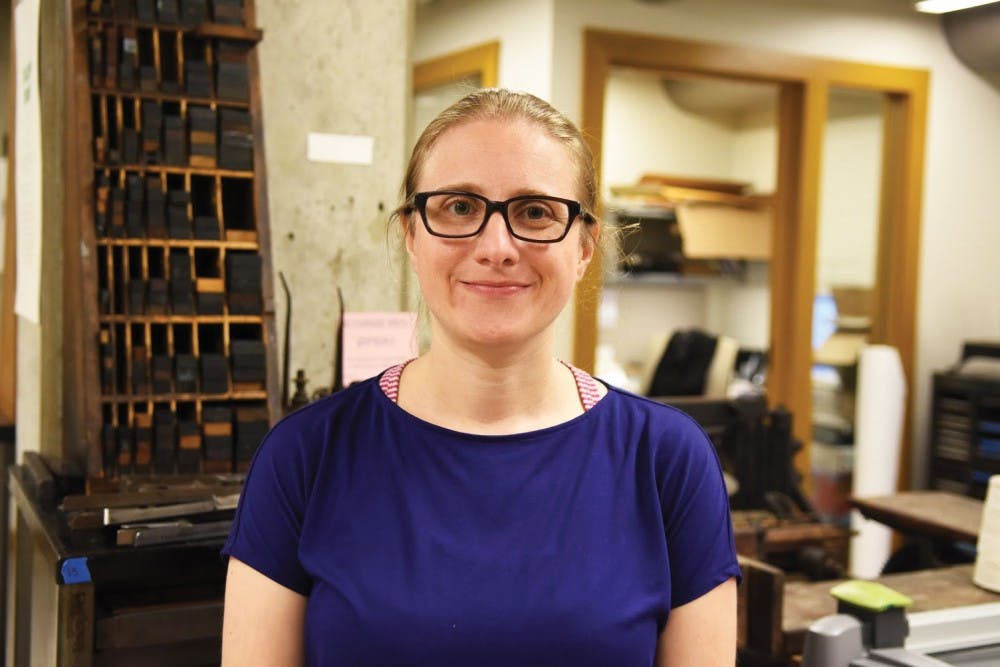Beneath the silent first floor of the Fisher Fine Arts Library, Penn students might be surprised to find a room filled with bustling printing presses and a hand press dating from approximately 1850 — the very kind Benjamin Franklin would have used in the late 18th century.
The Common Press is Penn’s official letterpress and book arts studio. In May this year, it welcomed its first full-time studio manager, Mary Tasillo, as part of several new initiatives to expand the Press' reach on campus.
In fall of 2017, the Common Press moved locations from the Morgan Fine Arts Building to the lower level of the Fisher Fine Arts Library for a cleaner and more accessible space that could hold more equipment.
An official advisory board for the Common Press was also recently formalized, consisting of six faculty members from Penn Libraries, Kelly Writers House, and Penn Design. The board is responsible for overseeing the development of the Press, which is available for any student to use for their own projects.
The Common Press was founded in 2006 in honor of the 300th anniversary of Benjamin Franklin’s birthday. Now, as more resources are being invested into the Press, it is particularly exciting to be able to direct its future, Tasillo said.

To make the facility more accessible, Tasillo's team is offering free workshops for students both in letterpress printing and in bookmaking. The first workshops began in September, and Tasillo said more workshops will be offered in the near future.
The three-hour workshops teach students how to set type and how to use and clean the presses. This then gives them the qualification to return during scheduled studio times to work on independent projects.
Tasillo emphasized that these independent projects are not limited to students studying design or writing. "It’s a vehicle for thinking through ideas. These ideas could be about science. They could be about business," she said. “The idea is that the Press can serve anyone and that it's a tool."
Tasillo also said that student groups can use the press to work on their extracurricular activities, citing the example of hand-printing voter encouragement posters.
College sophomore Alyson del Pino is one of the students who can frequently be found at the Common Press. A graduate of the New World School of the Arts, an arts-focused high school in Miami, del Pino began working at the Common Press through Kelly Writers House in her fall semester of freshman year, and said she has loved it since.
“When you hold something that has been printed this way, even if you have never seen the press or printed before, you can intuit how it happened,” del Pino said. “These letters were pressed into the paper, and I think that’s really cool — you get a mini history of the thing that you are holding.”
This semester, as part of the history class called Cultures of the Book, del Pino also made a visit to the Common Press.
“Visiting with the class was enlightening as a person who works there because sort of witnessing everyone’s reactions and how they interpreted Mary’s information," del Pino said. "It was a really cool experience to see how it can be something really mind-blowing."

David Comberg, a senior lecturer in the Fine Arts Department and one of the co-founders of the Common Press, also regularly incorporates visits to the Press into his class curricula. Last semester, students in his Design Practicum course worked with the Common Press to design a keepsake for the retirement of Vice Provost and Director of Libraries Carton Rogers.
Comberg, who is also a member of the Common Press advisory board, said being exposed to printing techniques is not just an important skill, but also provides important exposure to the history of typography.
“I’ve always been interested in materializing things to make it more effective for teaching and [more] satisfying for students," he said. “Also, it’s just really fun. Working in the Press is really social, you work very close to other people, get your hands dirty.”
Comberg will be teaching a course utilizing the Common Press in spring 2019 in collaboration with the English Writing, History, and Fine Arts departments that honors Walt Whitman's 200th anniversary and will celebrate Whitman’s work as a book maker and printer in addition to his accomplishments as a poet and activist.
College senior Jason Barr had his first experience with the Common Press through Comberg’s course and said it was an interesting introduction to different kinds of printing. He went on to do an internship at a museum in Philadelphia focusing specifically on silk screen printing, and made the decision to take another printing class this semester.
“I had no idea what the Common Press was until I got into it,” he said. “It showed me something that I didn’t know was a possibility before.”









